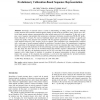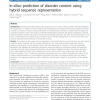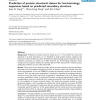44 search results - page 1 / 9 » Prediction of protein structural class using novel evolution... |
JCC
2008
13 years 5 months ago
2008
: Knowledge of structural classes is useful in understanding of folding patterns in proteins. Although existing structural class prediction methods applied virtually all state-of-t...
BMCBI
2011
12 years 9 months ago
2011
Background: Intrinsically disordered proteins play important roles in various cellular activities and their prevalence was implicated in a number of human diseases. The knowledge ...
BMCBI
2010
13 years 5 months ago
2010
Background: Prediction of protein structural classes (a, b, a + b and a/b) from amino acid sequences is of great importance, as it is beneficial to study protein function, regulat...
BMCBI
2008
13 years 5 months ago
2008
Background: We present a novel method of protein fold decoy discrimination using machine learning, more specifically using neural networks. Here, decoy discrimination is represent...
BMCBI
2008
13 years 5 months ago
2008
Background: A multiple sequence alignment (MSA) generated for a protein can be used to characterise residues by means of a statistical analysis of single columns. In addition to t...



